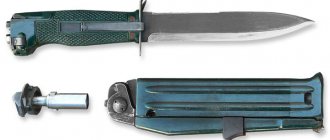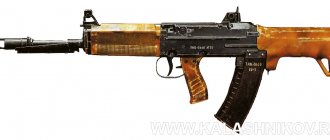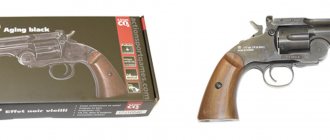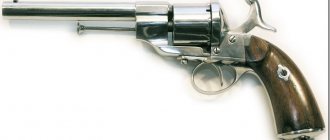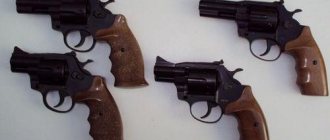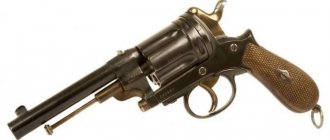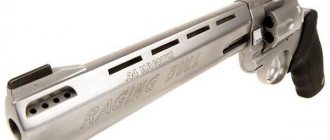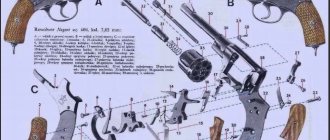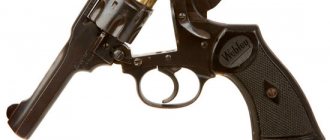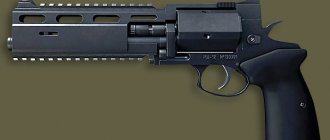Revolver OTs-38
Rice. 113. Revolver OTs-38
Main tactical and technical characteristics:
The silent revolver OTs-38 was developed by the late Igor Yakovlevich Stechkin at TsKIB SOO (now a branch of the Instrument Design Bureau, Tula) chambered for a silent special cartridge SP-4 and is intended to arm FSB operatives and other law enforcement agencies of Russia. The OTs-38 revolver is produced in small batches on special orders.
The silent revolver OTs-38 is one of the most unusual modern revolvers from a design point of view.
First, its self-cocking open-hammer firing mechanism features a manual safety (located on both sides of the frame) to ensure the weapon can be safely carried with the hammer cocked to ensure the first shot is fired with maximum speed and accuracy.
Secondly, the revolver fires not from the top (like the vast majority of analogues), but from the bottom chamber (!) of the drum, which ensures a low recoil shoulder and, as a result, minimal barrel bounce.
Thirdly, the mechanism for simultaneous reloading of the weapon is very unusual, for which the drum is tilted to the right and forward around a vertical axis located between the barrel and the laser center body. This drum mount ensures the most accurate alignment of the axis of the firing chamber and the barrel bore, necessary for firing cylindrical all-steel bullets of the SP-4 cartridge. Since SP-4 cartridges have a sleeve without a protruding rim, special flat steel clips for 5 cartridges are used for loading.
Fourthly, the revolver is equipped with an integrated laser sight (LCS), located in a casing above the barrel. The laser sight activation button is located above the trigger guard and is controlled by the thumb of the right hand. The revolver is also equipped with a conventional open sight with contrasting white inserts.
Revolvers of Russia
9-mm revolver "Cobalt" OTs-01 (TKB-0216)
1991 The Central Design and Research Bureau of Sports and Hunting Weapons (TsKIB SOO, Tula, now the State Unitary Enterprise Instrument Design Bureau) received a tactical and technical assignment from the Ministry of Internal Affairs to develop a revolver chambered for the standard 9×18 PM pistol cartridge. The experimental design work received the code “Cobalt” and was carried out in 1992 by the famous designer I. Ya. Stechkin together with B. V. Avraamov. The revolver received the designations OTs-01 (“TsKIB sample one”) and TKB-0216, and after modification it was named RSA (“Stechkin-Avraamov revolver”). The first two batches of 100 revolvers were manufactured directly at TsKIB SOO in 1993-1994. Once again, the revolver was publicly presented in 1995. The production of RSA was established by the Zlatoust Machine-Building Plant, as well as a mechanical plant in Uralsk (in Kazakhstan), where the documentation was transferred to TsKIB SOO. In fact, the RSA became the first combat revolver to go into small-scale production in Russia after the production of the Nagan revolver ceased.
The revolver is made according to the traditional design with a closed frame and a drum that flips to the left. The barrel is equipped with a strap, as well as a streamlined bulge-case for the cleaning rod-extractor. TsKIB samples had a polygonal barrel rifling, but in mass production they retained the usual technology, making right-handed rectangular rifling in the barrel.
The drum is equipped with an original shaped clip made of spring steel. To eject spent cartridges, you need to press the head of the extractor axis. The weight of the loaded clip is 65 g. The correct position of the drum in the frame before firing is ensured by the drum lock (latch). Unlike other revolver systems, in the RSA the lock in the form of a swinging lever is mounted in the upper part of the frame, i.e. much closer to the “combat” chamber. The position of the latch became, perhaps, the main feature of the Stechkin-Avraamov scheme. Reducing the length of the arm between the stop point of the latch and the axis of the “combat” chamber significantly reduces the backlash of the drum, better ensures the alignment of the chamber and the barrel bore, and reduces the load on the parts of the trigger mechanism.
The trigger mechanism is hammer-operated, with an open hammer and a cylindrical screw mainspring made of twisted wire located in the handle, allowing firing by self-cocking or with pre-cocking of the hammer. The trigger has a rebound and locks forward movement after the shot. When fired, the trigger strikes an inertial firing pin mounted in the frame. If the drum is not turned enough, the trigger is blocked and does not allow it to “reach” the firing pin. The trigger mechanism includes a vertically moving slider, which acts on the latch (stop) of the drum, pressing it down. The same slide plays the role of an automatic safety, which covers the rear end of the firing pin and prevents the trigger from striking it until the trigger is fully pressed.
The symmetrical plastic cheeks of the handle with a rough surface are attached to the frame with a screw and completely surround it, so that the shooting hand does not come into contact with the metal of the frame. For shooters with small palms, a rounded shape of the handle is offered; for those with large palms, a “flared” handle is offered, i.e. expanding downward. On the first batch of revolvers produced by TsKIB itself, wooden cheeks were installed. The bend and notch of the trigger guard are designed for two-handed shooting. At the bottom of the handle there is a ring for a safety cord or strap.
The fixed sight with a rectangular slot is mounted in the transverse groove of the frame and has thickened edges to protect against damage. The front sight is attached with a pin on a low base, its front edge is rounded for ease of wearing in a holster, and its back edge is beveled to prevent glare towards the sight. For the same purpose, the upper surface of the barrel strip and frame are shaded (covered with fine notches). The location of the sighting devices gives a relatively large length of the aiming line. The dispersion radius when shooting at a distance of 25 m is 10 cm. For shooting at dusk, the sight and front sight are equipped with white dots in the form of plastic inserts.
There was an experimental version with a shortened barrel and more powerful versions chambered for the high-impulse 9x18 PMM cartridge and the 9x19 Luger cartridge. They didn't generate much interest.
The so-called weapon was created as a weapon for private security guards and detectives. "service" revolver TKB-0216S chambered for 9×17 "Kurts" cartridge. The “civilian” version was the TKB-0216T traumatic revolver (manufactured by the Zlatoust Machine-Building Plant) chambered for a 9 mm RA cartridge with a rubber bullet.
Tactical and technical characteristics of OTs-01 / OTs-01S
Caliber, mm: 9 / 9 Cartridge: 9x18 PM / 9x17K (9 mm Short) Overall dimensions, mm: 200 x 130 x 40 Weight without cartridges, kg: 0.815 / 0.8 Trigger mechanism: double-action Drum capacity, pcs. : 6
Photo review of the RSA revolver (TKB-0216)
Notes[ | code]
- ↑ Revolver OTs-01 “Cobalt” // Viktor Shunkov. Military and service weapons of Russia. M., EKSMO Publishing House LLC, 2012. p.31-32
- Victor Ron. TsKIB revolvers // "Weapons" magazine, No. 3, 2010, p. 19
- A. I. Blagovestov. What they shoot from in the CIS / ed. A.E. Taras. Minsk, “Harvest”, M., LLC “AST Publishing House”, 2000. pp. 30-32
- ↑
- At the end of 1998, the cost of RSA was 3,350 rubles / piece. (IZH-71-100 - 2500 rubles / pcs.); as of October 2006, the cost of RSA is about 8,000 rubles / piece. (IZH-71 - 6000 rubles)
- Traumatic weapons: tomorrow comes today. // “World of Security”, No. 1 (170), January 2008, pp. 73-76
- Decree of the Government of the Russian Federation No. 40 of December 28, 1996
- Decree of the Government of the Russian Federation No. 460 of April 22, 1997 “On measures to provide legal entities with special statutory tasks with combat hand-held small arms”
- Decree of the Government of the Russian Federation No. 133 of February 2, 1998 “On measures to provide service weapons and special equipment to officials performing tasks for the protection of wildlife objects”
- Appendix No. 2 to Order of the Ministry of Internal Affairs of Russia No. 173 of February 17, 2001 “List of certain types and models of combat hand-held small arms, service and civilian weapons, cartridges for them, used by employees of paramilitary and private security guard units under internal affairs bodies”
- Decree of the Government of the Russian Federation No. 718 of December 5, 2005 “On awarding weapons to citizens of the Russian Federation”
- Decree of the Government of the Russian Federation No. 568 of September 16, 2006
- Decree of the Government of the Republic of Kazakhstan No. 383 of April 22, 2005
- Decree of the Government of the Republic of Kazakhstan No. 1014 dated October 2, 2010 “On approval of categories of customs officials authorized to carry, store and use firearms, lists of special means and types of firearms and ammunition used by customs officials”
REVOLVERS. Weapons of Russian law enforcement agencies of the 21st century
At the end of the twentieth century, interest in such seemingly long-forgotten weapons as revolvers arose again in Russia. Despite the fact that they were representatives of non-automatic weapons, in recent years quite a lot of new models of domestic revolvers have appeared, created taking into account the latest advances in both the design of the weapon itself and its production technology. Standard revolvers of classical designs were designed to use special revolver cartridges that had a sleeve with a rim (flange), which ensured their correct position in the drum chamber - the rim rested against the edge of the chamber, and also simplified the unloading and extraction of spent cartridges. The peculiarity of all modern Russian revolvers is that almost all of them, without exception, are chambered for the standard 9x18 PM pistol cartridge with a wafer sleeve (without a rim). Therefore, such cartridges required the use of special clips that fixed the position of the cartridges after they were loaded in the chambers of the drum. For a number of large-caliber revolvers, new ammunition with cartridge cases having a rim (flange) was developed.
9-mm Stechkin-Abramov revolver (RSA) “Cobalt” OTs-01
In the early 1990s, the gray-haired talented Tula gunsmith Igor Yakovlevich Stechkin, after thirty years of fruitful work on missiles, again returned to the origins of his design work - the creation of short-barreled weapons. Back in the late 1980s, the USSR Ministry of Internal Affairs required new models of service short-barreled weapons, more suited to the specifics of the police service, including revolvers. Based on the tactical and technical specifications issued in 1991 by the Ministry of Internal Affairs of the Russian Federation, Tula gunsmiths from the Central Design Research Bureau of Sports and Hunting Weapons (TsKIBSOO) received a new order for development work on the topic “Cobalt” to create a reliable, compact and an easy-to-maintain revolver chambered for the standard 9x18 PM pistol cartridge. This revolver was intended for use as a standard weapon of police units and internal troops.
9x18 Stechkin-Abramov revolver (RSA) “Cobalt” (TKB-0216) OTs-01, manufactured at the Zlatoust Machine-Building Plant.
For this purpose, TsKIBSSO designers Igor Yakovlevich Stechkin (1922 - 2001) and Boris Vasilyevich Abrahamov (1937 - 1994) As part of the Cobalt R&D project, in 1991 - 1992 they developed a 9-mm revolver TKB-0216 OTs-01 (OTs is an abbreviation for “TsKIBSOO sample”).
"Cobalt" was a small revolver of a classical design with a medium-sized solid frame (total length was 200 mm, barrel length - 75 mm, weight - 0.8 kg). The trigger mechanism allowed firing with both pre-cocking and self-cocking. This mechanism is equipped with a cylindrical mainspring mounted in the handle. In the firing position, the drum is fixed with a latch located on top, which ensures a more rigid alignment of the upper chamber of the drum and the axis of the barrel. In the revolver, in addition to the automatic safety that disconnects the hammer and the firing pin when the trigger is not pulled, there was also a blocking from firing when the cylinder was not fired. A fuse in the form of a vertical slide blocked the trigger and the drum lock. To remove spent cartridges, the drum was tilted to the left, and then all cartridges were simultaneously removed by a central extractor hidden inside the drum axis. The extractor rod in the firing position is located in the tide under the barrel. Acceleration of loading the drum with 9x18 PM pistol cartridges was ensured through the use of original plate clips (weighing 0.065 kg) designed for 6 cartridges, although the drum could be loaded one cartridge at a time. The pilot batch revolvers manufactured at TsKIBSOO had polygonal barrel rifling; the serial revolvers manufactured in Zlatoust received cheaper barrels with rectangular rifling. The trigger guard at the front had a recess for the finger, making it easy to shoot with both hands. Sights consisted of a front sight and rear sight with the possibility of making lateral corrections. The target firing range was 50 m. The initial speed of the cartridge was 315 m/s. Tests have shown fairly good combat accuracy, ease of use and high reliability of this weapon, although, according to the developers themselves, the guaranteed survivability of the revolver is only 3000 shots.
The design of the revolver does not include small detachable parts that accidentally fall out during incomplete disassembly. All metal parts of the revolver are made of high-quality weapons steel grades. In the gift version, metal parts are chrome-plated. Along with the standard version of the Cobalt revolver, a number of other models of this weapon were created: with a shortened barrel for concealed carry chambered for the 9x18 PM cartridge, as well as with a 75 mm long barrel, designed to use 9x19 Parabellum and 9x18 PMM pistol cartridges. However, they remained only in prototypes.
In 1994, a revolver under the designation Stechkin-Avraamov revolver (RSA) was adopted by the Ministry of Internal Affairs. For law enforcement agencies, serial production of these weapons was established by the Zlatoust Machine-Building Plant and the Ural Mechanical Plant. The RSA revolver was offered in two versions with wooden cheeks with rounded edges - for shooters with a narrow hand, and with wide plastic cheeks for shooters with a large hand.
To arm employees of security organizations with special statutory tasks, in 1996 a second version of the OTs-01S “Cobalt” service revolver TKB-0216S was released, designed to use the less powerful 9x17 “Browning Short” pistol cartridge.
In parallel with the creation of the OTs-01 revolver, the designers of TsKIBSOO developed another model of a revolver designed to use the 9x18 PM pistol cartridge: a fairly compact five-round OTs-11 “Nickel” (weight without cartridges - 0.5 kg; total length 160 mm, height - 106 mm, width - 34 mm). However, this model did not go beyond prototypes.
9-mm revolver AEK-906 “Rhinoceros”
In 1998 - 1999, the designers of the Kovrov Mechanical Plant developed another large revolver of a very unusual appearance (total length - 210 mm; height - 145 mm; thickness - 37 mm) for arming the police on the basis of the OTs-01 "Cobalt" revolver. It received the designation AEK-906 "Rhinoceros". The new six-shot revolver was designed to use both standard 9x18 PM pistol cartridges and more powerful 9x18 PMM and 9x19 Parabellum cartridges.
9x18 PM revolver AEK-906 “Rhinoceros”
Its design is distinguished by its originality, good balancing and accuracy of weapon fire, which were achieved by moving the barrel frame and cylinder lock to the lower part of the frame, while the cylinder axis is located above the barrel. Thus, Kovrov designers managed to bring the center of gravity of the revolver as close as possible to the axis of the barrel, reducing the recoil shoulder and lowering the firing line relative to the shooter’s hand. This design scheme made it possible to reduce the throwing of the revolver upward when firing and contributed to the rapid restoration of its position for aiming and firing the next shot. Thanks to the presence of a double-action firing mechanism with an open hammer, the revolver can be fired either by self-cocking or by manually pre-cocking the hammer. The self-cocking trigger force is 3 - 3.5 kgf. Before loading the drum, the cartridges are inserted into a metal flat spring clip. For reloading, the drum tilts to the left. The drum latch is located on the left side of the frame behind the drum.
The revolver has non-adjustable sights, including a front sight and rear sight. The target firing range is up to 50 m. A laser target designator laser can be mounted under the barrel to improve shooting accuracy. The revolver grip is equipped with wide plastic cheeks. The trigger guard is equipped with a protrusion for the index finger of the second hand, which allows shooting with both hands.
Along with the standard modification AEK-906 chambered for the 9x18 PM cartridge, Kovrov gunsmiths also produce its export modification AEK 906-1, chambered for the 9x19 Parabellum cartridge. The use of this cartridge made it possible to increase the initial speed from 290 to 365 m/s.
9-mm revolver R-92
In 1960, by decision of the Council of Ministers of the USSR on defense technology, all the work of the leading Soviet weapons Central Design Bureau (TsKB-14) in Tula on small arms and cannon weapons, along with equipment and most specialists, was transferred to the Central Design and Research Bureau of Sports and Hunting Weapons ( TsKIB SOO), located in the same city. In the period from 1960 to 1966, TsKB-14 was mainly engaged in the development of rocket technology. In 1966, TsKB-14, due to a completely new topic of work, was renamed the Instrument Design Bureau (KBP).
At the same time, the KBP was allowed to return to work on small arms and cannons. But intensive research and development work on small arms models began only in the late 1980s. KBP was able to get its hands on pistols and revolvers only in 1991, when competitors from TsKIBSOO began to carry out work within the framework of the Cobalt R&D to create a revolver chambered for the 9x18PM cartridge. In the struggle for a profitable customer in the person of the Ministry of Internal Affairs, KBP also launched work in this direction.
In 1991 - 1992, KBP designers under the leadership of V.P. Gryazev created a new revolver, designed to use the standard 9x18 PM pistol cartridge. It was “intended to increase the combat readiness and effectiveness of special units of the Ministry of Internal Affairs of the Russian Federation in the face of confrontation from organized crime.” A new weapon, very technologically advanced in production, with an unusual appearance, received the designation “R-92”. The first batches of this weapon were manufactured in Tula, and after it was adopted by the special forces of the Ministry of Internal Affairs of the Russian Federation, serial production of the revolver was mastered by the Kovrov Mechanical Plant.
9x18 revolver R-92
The specific appearance of the new revolver is explained by the innovative search for a more rational design. The designers sought to ensure maximum convenience for the concealed carrying of the R-92 revolver by the operational staff of the special forces of the Ministry of Internal Affairs and the ability to fire a shot from a limited space, including from a pocket or bag. That is why the revolver was created according to the so-called “pistol” layout, in which the trigger is half-closed and the handle and trigger mechanism are shifted forward. This is what made it possible, while maintaining the specified barrel length (63 mm), to significantly reduce the total length of the revolver (length - 157 mm; height - 120 mm; width - 35 mm) and ensure the convenience of concealed carry.
The presence of a double-action trigger mechanism provided the ability to fire both self-cocking and with pre-cocking and guaranteed constant combat readiness and good shooting accuracy. Due to the many problems created by the emergency removal of such a weapon with an open trigger from clothing or a holster, a new trigger solution was chosen for the R-92 revolver, almost completely hidden by the frame and handle lug, but this cannot be attributed to design success.
The mainspring is mounted inside the handle. A special feature of the firing mechanism is that when pressed, the trigger does not rotate, but progressively moves backward, interacting with the trigger through the lever. The force on the trigger when firing by self-cocking is no more than 5.5 kg. It was assumed that this would improve shooting accuracy. Although, as one of the leading American experts in the field of small arms, Charles Cutshaw, later wrote about this revolver, “it is obvious that the P-92 was designed taking into account that it could be easily hidden under clothing, and although its general layout (the forward trigger hook, shape of the handle) is designed for exactly this, overall the P-92 produces an impression that, at best, can be described as “clumsy.”
The frame of the R-92 revolver is made of light alloys by casting; steel drum; the steel barrel is pressed into the frame (total weight - 0.52 kg). In the firing position, the drum is fixed with a latch located on the left side of the frame. When the latch was pulled back, the drum was tilted to the left for loading or removing spent cartridges. The simultaneous extraction of all spent cartridges reduced the time for loading the drum with 5 9x18 PM pistol cartridges inserted into a plastic plate clip, which allows simultaneously loading all chambers of the drum and removing spent cartridges. The revolver drum allows the installation of cartridges without a clip, but in this case, the simultaneous extraction of spent cartridges becomes impossible, and they have to be removed one by one. Sights consist of a front sight and a non-adjustable rear sight, molded at the rear of the upper part of the frame. Due to the short length of the aiming line, aimed shooting is possible at a distance of no more than 25 m. The small handle of the revolver, combined with the low mass of the revolver and the fairly high power of the cartridge, leads to painful sensations in the shooter’s hand after the first shot.
9x17 service revolver R-92 C
And here it makes sense to once again turn to the opinion of C. Cutshaw regarding this revolver: “Although I did not have the opportunity to personally shoot from a revolver, the relative position of the handle, trigger and barrel is such that it is possible to handle the R-92 C.” 92 and it’s hardly convenient to aim from it. Moreover, the barrel axis is located high above the shooter's hand, which should increase recoil and move the barrel upward when shooting. Perhaps, for a weapon chambered for not very powerful ammunition, such as the R-92, this circumstance is not a serious drawback, but since the R-92 is a revolver, it would be possible to fire new modernized cartridges of increased power from it.”
Initially, it was decided to arm not only employees of the Ministry of Internal Affairs, but also judges with this revolver. However, the lack of financial resources led to the collapse of this venture.
Therefore, soon, on the basis of the R-92 revolver, KBP designers developed the R-92 C service revolver, designed for the use of 9x17 Browning Short pistol cartridges, for arming security personnel. The main technical solutions contained in the R-92 were used to create the 12.3 mm U-94 revolver, which is actually its enlarged version. In addition, mass production of another modification of it was mastered - the “gas” revolver GR-92, designed to use the PG 9x22 cartridge with tear gas.
Until 1996, the Kovrov Mechanical Plant produced approximately 3,000 units of R-92 and 92C revolvers.
12.3 mm large-caliber revolver "Udar" U-94
After October 1993, the desire of high officials of the Ministry of Internal Affairs of the Russian Federation to arm law enforcement agencies with new powerful weapons capable of fighting all violators of law and order in various situations gave rise to rather unusual designs of revolvers designed to use special cartridges created on the basis of the cartridge case of the .32 hunting cartridge caliber.
In the autumn of the same year, in accordance with the tactical and technical specifications of the Ministry of Internal Affairs of the Russian Federation, which provided for the creation of powerful weapons to solve a wide range of special tasks, Tula gunsmiths from KBP and Klimov gunsmiths from TsNIITOCHMASH began creating a revolver as part of the R&D project on the topic “Strike”. The basis for this work was a complex of 12.3 mm revolver cartridges: with a steel bullet; with a plastic bullet; pyro-liquid (with a dye bullet) and noise.
When creating the revolver, which received the designation “T-93,” KPB designers used the 9-mm R-92 revolver as a prototype. The large caliber of this weapon with a rifled barrel, combined with a powerful cartridge, provided it with superiority over other models of personal weapons in terms of the stopping effect of the bullet. Structurally, the T-93 is a significantly enlarged version of the P-92 (its total length became 173 mm, height - 136 mm, thickness - 44 mm), and the 9-mm rifled barrel was replaced by a smooth barrel of 12.3 mm caliber.
12.3x40R large-caliber "Udar" "T-93" revolver, developed at KBP
Double-action trigger mechanism, and firing can be carried out either by self-cocking or with manual pre-cocking of the hammer (the trigger shank is also semi-hidden and barely protrudes from the frame ), which guaranteed the constant combat readiness of the weapon. The forward movement of the trigger, along with a uniform trigger force, ensured high accuracy and accuracy of fire.
The drum of the T-93 revolver was designed to hold 5 rounds. For reloading, the drum was tilted to the left. In the combat position, it was fixed with a latch located on the frame on the left side. The Udar revolver was reloaded using a five-round star clip. The cartridges were held in the clip by two steel latches that ensured they were aligned, making loading easier. When cartridges were inserted into the drum, the front latch moved back to the rear and stopped, resting against it. After this, the drum closed and the revolver was ready to fire. The simultaneous extraction of all spent cartridges reduced the time to reload the revolver.
The "Udar" revolver had non-adjustable sights designed for a firing range of up to 25 m.
For firing from the Udar revolver, several types of powerful 12.3x40R cartridges were used: - a combat cartridge with a bullet with a steel core of armor-piercing action ensures reliable defeat of an enemy using personal armor protection (at a distance of 25 m, the bullet pierces a sheet of steel 5 mm thick); — a live cartridge with a steel bullet of high stopping power (at a distance of 25 m the bullet has an energy of 49 J).
Soon after the tests, this weapon was modified. First of all, complaints were made about the inconvenience of shooting due to the presence of a small and narrow revolver grip, which did not quite correspond to the power of the 12.3 mm cartridges used. Along with the appearance of a wider handle for better stability, it was recommended that this very powerful weapon be fired with two hands. Therefore, several new models of this revolver will soon appear, including: - the Udar U-94 combat revolver, where, for the convenience of such shooting, the trigger guard received a special protrusion in front; — service revolver “Udar-S”, designed for firing special cartridges of reduced power 12.3x22R with a lower initial speed. This non-lethal cartridge was equipped with either a rubber bullet or three plastic balls, used to suppress riots and hooliganism (the dispersion diameter at a distance of 25 m is no more than 200 mm). The Udar-S service revolver was created to arm security companies and security services; — training revolver “Udar-TS”, designed for firing paint bullets during training sessions and suppression of hooliganism. Firing live ammunition from this revolver was excluded. To fire from it, 12.3x22R cartridges with a dye bullet were used, which served to “mark” offenders and perform training exercises (the dispersion diameter at a distance of 25 m is no more than 200 mm), as well as shot and noise cartridges.
The Udar revolver did not take root in law enforcement agencies, although it was partially adopted by the Ministry of Internal Affairs of the Russian Federation for certain categories of police officers, primarily due to dubious advantages over pistols of “normal” calibers, as well as its impressive dimensions, limiting the possibilities of hidden wearing. The armed forces also ignored such a design innovation of the Tula gunsmiths, despite the simplicity and reliability of the functioning of all mechanisms in the most unfavorable conditions.
The Udar-S revolver in small quantities, together with its “younger” brother - the R-92S revolver chambered for the 9x17 Browning Short cartridge, was used in non-state security structures - private security companies and security services.
In 2006, Kovrov plant named after. Degtyarev mastered the mass production of another modification of the Udar revolver - the 13-mm Ratnik revolver, designed for the use of 13x45R cartridges with traumatic and tear equipment. Moreover, in order to achieve a greater stopping effect while complying with medical standards for specific energy, the traumatic cartridge is equipped with not one, but two rubber bullets weighing about 2 grams each (similar to the two-bullet cartridge 10x32T of the Leader traumatic pistol). Unlike the Udar, the Ratnik does not have a steel frame, but is made of aluminum alloys, which reduces the weight from 0.8 kg to 0.43 kg; In addition, there is no clip to speed up the loading of the revolver. When shooting at a distance of 5 m, two rubber bullets of one cartridge had a spread of 5 to 15 cm.
12.3 mm large-caliber revolver "Udar"
The 12.3-mm large-caliber revolver complex "Udar" was created in 1994 at TsNIITOCHMASH as part of the research and development work on the topic "Udar", based on the same technical specifications of the Ministry of Internal Affairs of the Russian Federation, according to which the Tula KBP developed its large-caliber revolver U-94 "Udar" . Therefore, the product of the Klimov gunsmiths also received the designation “Udar”.
The “Udar” revolver was intended for a wide range of tasks solved by law enforcement agencies to maintain law and order, which was ensured by a wide range of special ammunition developed for it and supported the entire range of means of influencing violators of public order, used by the Ministry of Internal Affairs.
12.3x40R large-caliber "Udar" revolver, developed at TsNIITOCHMASH.
This weapon also had quite large dimensions and weight: total length 210 mm, barrel length - 63 mm; weight without cartridges - 0.95 kg. The one-piece frame of the Udar revolver is made of high-quality weapon steel. The revolver had a double-action trigger mechanism, and firing could be done either by self-cocking or by manually pre-cocking the hammer. The drum was designed to hold 5 rounds. The design of the revolver made it possible to quickly change the drum, which was pre-equipped with the necessary ammunition. The large dimensions of the weapon made it possible to fire with both hands, while the trigger guard was provided with a protrusion for the index finger of the second hand. Sights consisted of a front sight and rear sight, with the possibility of making lateral corrections.
The revolver had two types of combat cartridges 12.3x40R (with bullets with steel and lead cores), and the cartridge with a steel core ensured the destruction of a living target at ranges of up to 50 m. In terms of its lethal effect, it was twice as powerful as the standard 9x18 PM cartridge. The accuracy of firing a live cartridge from a sitting position with emphasis at a distance of 25 m was r50 - 4 cm.
Along with this, several more types of ammunition were created for the “Udar” revolver: - a revolver cartridge with a plastic bullet, which inflicted a shocking blow on the attacker without serious bodily harm (as the developers of this cartridge themselves wrote, it is: “... a good simulator of a rubber baton”). The target firing range of this cartridge was 15 m. The accuracy of fire with a cartridge with a plastic bullet from a sitting position from a rest at a distance of 25 m was r50 - 20 cm; - a revolving pyro-liquid cartridge that provides temporary neutralization of an attacker due to the targeted throwing of a liquid containing irritants, with an aiming range of 5 m. The accuracy of fire with a cartridge with a plastic bullet from the “sitting from rest” position at a distance of 4 m was r100 - 15 cm; - a revolver noise cartridge, used to simulate the sound of a live cartridge being fired and to produce a sound signal. At the same time, the sound pressure level of the noise cartridge at a distance of 1.5 m was at least 150 dB.
The revolver kit included several drums, pre-loaded with cartridges for various purposes, depending on the upcoming combat mission.
However, apparently, this revolver remained only in prototypes.
12.5 mm large-caliber revolver OTs-20 “Gnome”
In 1993 - 1994, the designers of the Tula TsKIBSSO developed a fundamentally new design for the seven-shot OTs-17 Titan revolver, designed to use standard 9x18 PM pistol cartridges. It differed from others of its kind in its simplicity of design and modular disassembly. The revolver consisted of three main parts: a frame, a drum and a trigger mechanism. A double-action trigger mechanism was mounted on a single frame made of high-quality weapon steel. The peculiarity of this mechanism is that it is assembled in the form of a single block with a trigger and mainspring. Thanks to this, partial disassembly of the revolver for cleaning and inspection was carried out almost instantly and required only a cleaning rod.
However, such weapons with fairly large weight and dimensions did not interest potential customers from the Ministry of Internal Affairs (weight - 0.75 kg; total length 205 mm; height - 125 mm; width - 40 mm). Therefore, soon, as part of the Udar R&D project, TsKIBSOO designers on its basis are creating a new revolver complex OTs-20 Gnome, consisting of a 12.5 mm smoothbore revolver and special cartridges for it, which expanded the capabilities of firing a wide range of ammunition. This weapon was intended to destroy closely located targets and had a very high lethal effect.
The new five-shot smoothbore revolver had a large mass (1.1 kg without cartridges) and dimensions (total length 250 mm; height - 132 mm; width - 45 mm), the barrel length was 100 mm. Moreover, to increase the service life of the barrel, its bore was chrome-plated, and the drum chambers were also chrome-plated.
The problem of the alignment of the drum chambers with the barrel was solved in an unusual way in this revolver. In addition to the standard stopper, the drum is equipped with five grooves, one of which includes a special protrusion of the trigger before firing. If this does not happen, then firing a shot is excluded. An involuntary shot is also practically impossible, since the trigger interacts with the spring-loaded striker only when the trigger is directly pressed.
For loading and unloading, the drum was tilted to the left. The drum was loaded with cartridges one by one, and the spent cartridges were extracted simultaneously. The trigger mechanism made it possible to fire both self-cocking and with pre-cocking of the hammer. Revolver disassembly is modular.
The "Gnome" revolver was produced with a plastic handle, but at the customer's request it was possible to supply it with a handle made of hardwood of valuable species. Sighting devices - front and rear sights with the possibility of making lateral corrections, designed for an effective firing range of up to 25 m. To facilitate aiming in the dark, sighting devices could be equipped with bright white plastic inserts. The OTs-20 revolver also provided for the use of a laser target designator mounted on a frame under the barrel. This target designator was turned on when you wrapped your hand around the handle of the revolver, allowing you to fire 500 aimed shots without recharging.
The ammunition developed for the revolver was a metal cartridge case of a 32-caliber hunting cartridge with a length of 40 mm, equipped with several types of bullets, including: - STs 110 - a cartridge with a steel bullet weighing 11 g and a muzzle energy of 900 J, designed to destroy manpower in bulletproof vests. This bullet has an initial speed of 400 m/s, and at a distance of 50 m it pierces a steel sheet 3 mm thick. At a distance of up to 25 m, the bullet penetrates a standard 4.5 mm thick armor element. This means that all body armor, up to class 4 inclusive, do not provide protection against a steel bullet from the STs 110 cartridge; — STs 110-02 — shot cartridge containing 16 lead pellets with a diameter of 4.5 mm, with a total weight of 10 g. The cartridge is used when shooting in difficult conditions, in the absence of information about the exact location of the enemy (in a bush, in a cloud of smoke, etc. .), as well as for hitting group targets; — STs 110-04 — a cartridge with a lead bullet weighing 12 g and an initial speed of 350 m/s. In terms of stopping power, this bullet is superior to most modern pistol and revolver bullets.
In addition, there is a cartridge with a traumatic rubber bullet, which has a great stopping effect.
The OTs-20 "Gnome" revolver was adopted by units of the Ministry of Internal Affairs and internal troops.
12.5 mm large-caliber revolver DOG-1
The large-caliber service revolver DOG-1 was also developed by employees of the Izhevsk State Technical University (IzhSTU) within the framework of the Law of the Russian Federation “On Weapons”. It was intended for arming non-state security structures - private security companies and security services, therefore its design was subject to the restrictions of the law that short-barreled service rifled and smooth-bore weapons must have a muzzle energy of no more than 300 J, and bullets of cartridges for these weapons cannot have cores made of hard materials. In this regard, the following design was chosen for the new weapon - a smooth barrel and a large caliber, which are the most optimal for stopping effect cartridges.
DOG-1 is an original revolver complex consisting of a 12.5 mm smoothbore five-shot revolver and special cartridges for it. It was a large (total length 212 mm, barrel length 90 mm), heavy specimen (weighing 1.0 kg) of a very unprepossessing appearance.
12.5x35R large-caliber revolver DOG-1
The DOG-1 revolver is characterized by a solid steel frame. The revolver had a double-action trigger mechanism, which made it possible to fire not only by self-cocking, but also by manually pre-cocking the hammer. The barrel length is 90 mm. To ensure identification of a bullet fired from the barrel, there are special protrusions in its channel near the muzzle. Reloading a revolver is carried out according to the simplest scheme - replacing the drum with spent cartridges with a loaded drum. Such a scheme assumes the presence of one or two additional drums, which can be equipped with cartridges of various types. Replacing a loaded cylinder takes less than 5 seconds, which ensures a good practical rate of fire for the revolver. Non-adjustable sighting devices, designed for a range of up to 20 m, consisted of a front sight and rear sight. DOG-1 revolvers had angular handles with wooden cheeks.
For firing from the DOG-1 revolver, special 12.5x35 cartridges are used, which are a shortened cartridge case of a 32-caliber hunting cartridge: - a combat cartridge with a round lead bullet weighing 12 g; — auxiliary stopping action cartridge with plastic shot; — lighting cartridge; — signal cartridge for supplying light signals; — a blank cartridge for giving sound signals.
In addition, cartridges for this revolver can also be equipped with so-called non-lethal means: a traumatic rubber bullet; with CS irritant gas as well as a dye bullet.
In terms of its lethality at all distances, the DOG-1 is inferior to the standard PM combat pistol. At the same time, the lethal effect of a lead bullet remains at firing ranges of up to 20 m. The caliber of the revolver is such that a hit to parts of the body (arm, leg) that are not vital for the body, however, unlike rifled weapons, will certainly incapacitate the attacker . In this case, the bullet causes a state of shock, which will not only prevent the attacker from continuing aggressive actions, but will also prevent him from leaving the crime scene. The ballistic data of the revolver, the caliber, and the spherical shape of the live cartridge bullet ensure its short emission: at ranges over 20 meters, the bullet speed quickly drops, the trajectory sharply decreases, and the destructive range if it misses is significantly reduced. At ranges greater than 25 m, it is unlikely that a person who accidentally finds himself in the shooting zone will be hit.
Sergey Monetchikov Illustrations from the author’s archive
Options and modifications
RSA (Stechkin-Abramov Revolver) - variant chambered for 9×18 mm PM cartridge
- OTs-01 "Cobalt"
- the first model, was produced in Tula at the facilities of TsKIB SOO. It is distinguished by the presence of polygonal rifling in the barrel bore. - TKB-0216
- the second model, serial production began at the Zlatoust Machine-Building Plant (city of Zlatoust) and since 1994 - at the Ural Machine-Building Plant. It is distinguished by the presence of four rectangular rifling in the barrel bore. Since 2002, FSUE ZMZ has not produced combat revolvers.
- OTs-01S (TKB-0216S)
- a service version chambered for 9×17 mm K, mass-produced since 1996, intended for arming employees of private security structures (it did not receive significant distribution, since it was inferior in efficiency to the IZH-71, but at the same time had a higher cost), discontinued. - TKB-0216T “Agent”
is a traumatic revolver chambered for .380 ME GUM caliber cartridges. Designed as a civilian self-defense weapon and mass-produced at the Zlatoust Machine-Building Plant since September 2005. The revolver went on commercial sale after certification, but was discontinued at the end of 2007.
Encyclopedia of weapons
Revolver Stechkin-Avraamov RSA / TKB-0216 / OTs-01 Cobalt, Russia
Tactical and technical characteristics of OTs-01 / OTs-01S Cobalt USM - double action Caliber, mm - 9x18 PM, 9x17 Browning Weight without cartridges, g - 800-815 Overall dimensions, mm - 200x150x40 Drum capacity, cartridge.
— 6 Initial bullet speed, m/s — 315 The Stechkin-Avraamov revolver (RSA), also known as OTs-01 or TKB-0216, was developed in the early 1990s by designers Stechkin and Avraamov at TsKIB SOO (currently part of Instrument Design Bureau) in the city of Tula.
The revolver, created within the framework of the “Cobalt” theme by order of the Ministry of Internal Affairs, was intended to arm law enforcement officers and was designed for standard 9x18 PM pistol cartridges.
Somewhat later, on its basis, a service version of the revolver was created for private security companies, chambered for the 9x17 Browning cartridge. The “police” version of the RSA revolver has not received much distribution, and the service version of the OTs-01S revolver is produced at KBP and the Zlatoust Mechanical Plant to this day.
The trigger mechanism allowed firing with both pre-cocking and self-cocking. This mechanism is equipped with a cylindrical mainspring mounted in the handle. In the firing position, the drum is fixed with a latch located on top, which ensures a more rigid alignment of the upper chamber of the drum and the axis of the barrel.
The firing pin is located in the frame of the weapon; the design includes an automatic safety lock that prevents the primer from being punctured when the trigger is not pressed. In the revolver, in addition to the automatic safety that disconnects the hammer and the firing pin when the trigger is not pressed, there was also a blocking from firing when the cylinder was not fired. A fuse in the form of a vertical slide blocked the trigger and the drum lock.
The Stechkin-Avraamov OTs-01 revolver uses a reloading scheme traditional for revolvers with simultaneous extraction of cartridges from a 6-shot drum that folds to the side (to the left). To remove spent cartridges, the drum was tilted to the left, and then all cartridges were simultaneously removed by a central extractor hidden inside the drum axis.
The extractor rod in the firing position is located in the tide under the barrel. Acceleration of loading the drum with 9x18 PM pistol cartridges was ensured through the use of original plate clips (weighing 0.065 kg) designed for 6 cartridges, although the drum could be loaded one cartridge at a time.
The pilot batch revolvers manufactured at TsKIBSOO had polygonal barrel rifling; the serial revolvers manufactured in Zlatoust received cheaper barrels with rectangular rifling. The trigger guard at the front had a recess for the finger, making it easy to shoot with both hands.
Sights consisted of a front sight and rear sight with the possibility of making lateral corrections. The target firing range was 50 m. The initial speed of the cartridge was 315 m/s. Tests have shown fairly good combat accuracy, ease of use and high reliability of this weapon, although, according to the developers themselves, the guaranteed survivability of the revolver is only 3000 shots.
The design of the revolver does not include small detachable parts that accidentally fall out during incomplete disassembly. All metal parts of the revolver are made of high-quality weapons steel grades.
In the gift version, metal parts are chrome-plated. Along with the standard version of the Cobalt revolver, a number of other models of this weapon were created: with a shortened barrel for concealed carry chambered for the 9x18 PM cartridge, as well as with a 75 mm long barrel, designed to use 9x19 Parabellum and 9x18 PMM pistol cartridges. However, they remained only in prototypes.
In 1994, a revolver under the designation Stechkin-Abramov revolver (RSA) was adopted by the Ministry of Internal Affairs. For law enforcement agencies, serial production of these weapons was established by the Zlatoust Machine-Building Plant and the Ural Mechanical Plant. The RSA revolver was offered in two versions with wooden cheeks with rounded edges - for shooters with a narrow hand, and with wide plastic cheeks for shooters with a large hand.
To arm employees of security organizations with special statutory tasks, in 1996 a second version of the OTs-01S “Cobalt” service revolver TKB-0216S was released, designed to use the less powerful 9x17 “Browning Short” pistol cartridge.
In parallel with the creation of the OTs-01 revolver, the designers of TsKIBSOO developed another model of a revolver designed to use the 9x18 PM pistol cartridge: a fairly compact five-round OTs-11 “Nickel” (weight without cartridges - 0.5 kg; total length 160 mm, height - 106 mm, width - 34 mm). However, this model did not go beyond prototypes.
‹ GSh-18 Up OTs-11 Nickel ›
- 36651 views
